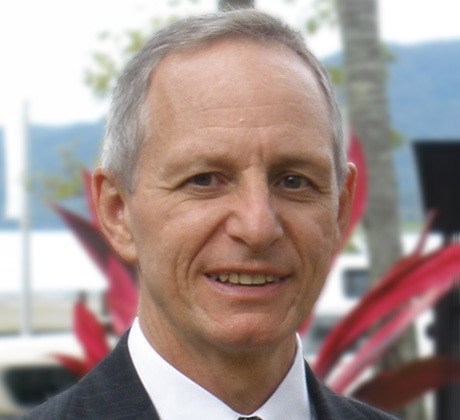Rear Admiral Boyd Chapman Robinson

Boyd Chapman Robinson was born in 1956 and grew up on a tobacco farm in north Queensland before joining the RAN College in 1972 as a 15 year old Cadet Midshipman. Due to changes in the HMAS Creswell course curriculum, his college class completed training cruises in HMAS Duchess in 1975 and again in 1976. He graduated from the college in July 1976 as dux of the course and with the US Naval Institute Prize for navigation. Robinson then completed general training in the fleet as a midshipman before specialising as a supply officer in 1977.
As a junior supply officer Boyd Robinson served ashore in HMAS Moreton (twice), HMAS Cerberus and Fleet Headquarters (twice). He served at sea in the destroyer escort HMAS Torrens and the tankers HMA Ships Supply and Success. In 1987 he was awarded a Bachelor of Commerce degree, from the University of Queensland, following ten years of part time and external studies. He completed the year long Royal Navy Staff Course at the Royal Naval College, Greenwich in 1989 during which time he was promoted Commander. In 1990, upon his return to Australia, he was appointed as Officer-in-Charge of the Navy Supply School at Cerberus.
Following the Iraqi invasion of Kuwait in late 1990, Commander Robinson was appointed as the RAN Liaison Officer in Muscat and in command of the Logistics Support Element established to support RAN ships in the Gulf of Oman. This role was expanded in 1991, prior to the US led liberation of Kuwait, to coordinate in-theatre support for all deployed Australian forces in the Persian Gulf area. For his service he was appointed as a Member of the Order of Australia (AM) in the 1991 Queen's Birthday Honours List.
On his return to Australia, from the Gulf, Boyd Robinson was appointed as the executive officer of the RAN's main training establishment, HMAS Cerberus. During this posting he implemented a major Defence reform program for base support, effectively combining all executive, supply and technical functions at Cerberus into to a single base support department of some 400 sailors and civilians. In 1994 he completed the Joint Services Staff Course in Canberra.
Following staff course he conducted a major study into the role of supply officers in the RAN, resulting in broad and far reaching changes to employment and training for supply officers in the future. In 1995 he joined HQADF as Staff Officer Joint Logistics Planning with responsibility for deliberate operational planning and for the development of combined and joint logistics doctrine. Robinson was promoted Captain in 1996 and posted as Director of Supply Policy during which time he contributed to the implementation of sweeping changes to logistics support in Navy and across the ADF as part of the Defence Reform Program. In 1997 Captain Robinson was posted as Director of Preparedness in the newly created Navy Headquarters in Canberra and directed to develop a capability management framework in the headquarters to support the Chief of Navy's post Defence Reform Program role as the Navy Capability Manager.
During 1999-2001, Boyd Robinson took long service leave to live in Texas, USA where his wife was completing her final posting as a flying instructor in the US Air Force. In 2001 he was selected to attend the National Defence University international fellows program in Washington, DC, graduating in 2002 with distinction and a Master of Science degree in national resource strategy. On his return to Australia he was promoted Commodore and appointed as the inaugural Chief of the Combat Support Group in Fleet Headquarters.
In 2003 Commodore Robinson was interviewed by the Minister for Defence (Senator Robert Hill) and subsequently appointed to the most difficult job of his naval career as the Director General Submarines in the Defence Materiel Organisation in Canberra. He spent the next four years breaking new ground that included conducting the first submarine full cycle dockings, resetting the usage upkeep cycle, guiding the development of the Australian Submarine Corporation so it became a competent and cost-conscious maintainer, working with Kockums AB to resolve residual design issues, acquiring a new heavyweight torpedo and a new combat control system by way of joint leading-edge development projects with the US Navy. In addition he had to argue for additional funding beyond that already allocated in the budget; which was considered already too high by many but was later realised to be inadequate for the materiel support required. Commodore Robinson also held additional naval appointments as Chairman of Navy Health Ltd (2002-2004) and professional Head of the Navy Supply Community (2004-2007).
Robinson was promoted Rear Admiral in June 2007 and appointed as Head of Maritime Systems (HMS) within the Defence Materiel Organisation with responsibility for the acquisition and in-service sustainment of ships, submarines, naval ranges, weapons systems and sensors as well as procurement of all Defence fuel. As HMS he initiated many organisational and process reforms to improve delivery of sustainment to the RAN.
Rear Admiral Robinson retired from the RAN on 11 December 2009.


